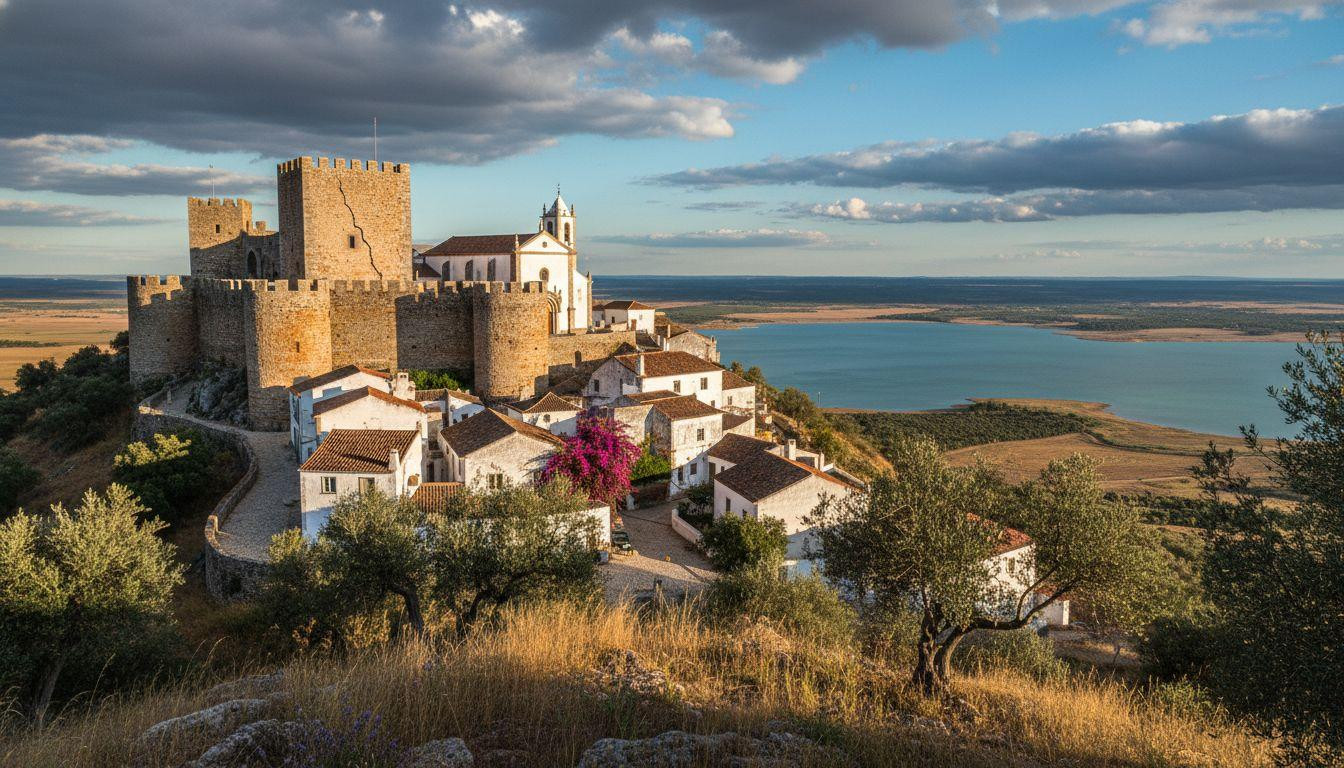Dawn breaks at 6:47 AM as whitewashed walls catch November light 899 feet above Lake Alqueva. Steam rises from a village bakery while the 14th-century castle stands silent above empty cobblestone streets. This is Monsaraz, where 1,200 residents guard 900 years of Alentejo history in Portugal’s forgotten interior.
Forty minutes from Évora’s tourist crowds, this medieval fortress village offers something rarer than coastal cliffs or famous vineyards: authentic solitude under Europe’s darkest skies. While millions rush toward Lisbon and Algarve beaches, Monsaraz preserves what Portugal’s commercialized destinations have lost.
Where Alentejo plains meet Europe’s largest lake
Monsaraz occupies a strategic hilltop 100 miles east of Lisbon, perched above Lake Alqueva’s 96-square-mile turquoise expanse. Europe’s largest artificial reservoir was created in 2002. The village sits at 899 feet elevation within Évora District, close to Spain’s border.
Access requires commitment: Lisbon’s Humberto Delgado Airport lies 2 hours 15 minutes west via well-maintained roads. Car rental costs $40-60 daily. Or reach it in 40 minutes from Évora’s historic center.
No trains reach Monsaraz; the journey rewards those willing to trade convenience for authenticity. November temperatures hover around 64°F days, 46°F nights. Soft diffused light creates perfect conditions for photographing limestone facades.
Nine centuries of Templar walls and starlit skies
The medieval kingdom frozen in limestone
Monsaraz’s whitewashed walls conceal architectural layers spanning nine centuries. Liberated from Moorish control in 1167 by knight Geraldo Sem Pavor, definitively reclaimed by Knights Templar and King Sancho II in 1232, the village crystallized around its 14th-century castle built under King Dinis.
Igreja Matriz de Nossa Senhora da Lagoa rises from ruins of a plague-destroyed Gothic predecessor. The Renaissance church houses a 14th-century marble tomb of Gomes Martins Silvestre, first Templar mayor. Medieval walls remain intact, creating one of Portugal’s most atmospheric National Monument villages.
Where dark skies reveal 4,000 stars
Proximity to Dark Sky Alqueva Reserve transforms Monsaraz into celestial theater. November’s 5-hour daily sunshine yields to unpolluted night skies revealing constellations lost to urban glow elsewhere. Stargazing tours cost $22-44, far less than commercialized astronomy destinations.
Unlike Tuscany’s commercialized hilltowns charging $200-275 nightly, this village 820 feet above Sicily’s coast offers similar medieval atmosphere. Monsaraz delivers guesthouses at $55-88, mid-range pousadas $100-165.
Living between castle ramparts and lake reflections
Walking through Templar history
Monsaraz Castle and Igreja Matriz sit within 500-meter walking radius. Cobblestone streets wind past schist-and-limestone facades unchanged since medieval times. The castle ramparts provide 360-degree Alentejo plains views.
Entry costs $5.50, a fraction of Évora’s cathedral complex fees. November’s quiet season means empty ramparts at sunrise, when golden light floods the valley and Lake Alqueva’s turquoise waters shimmer below. Nearby São Pedro do Corval offers pottery traditions spanning centuries.
Alentejo’s soul on a plate
Traditional restaurants serve Açorda Alentejana (garlic-coriander bread soup), Porco Preto (black pork), Migas (garlic bread), regional cheeses, and Évora wines for $16-28. Local meals cost $11-22, 40% less than Lisbon’s tourist districts.
Morning markets sell olive oil, cork crafts, and honey harvested from surrounding plains. This village of 200 people in Catalan France shares similar amber-glow sunset lighting on stone architecture.
Solitude that Tuscany sold away decades ago
Monsaraz delivers what Italy’s famous hilltowns commercialized into oblivion: genuine quiet. While San Gimignano corrals millions behind selfie queues, Monsaraz’s 50,000 annual visitors (mostly Portuguese day-trippers from Évora) vanish by sunset.
November amplifies this solitude. Thirteen days of moderate rainfall spread across the month create contemplative mist-morning atmospheres. The village feels like stepping through a portal: 900 years preserved not as museum, but as living rhythm.
Dawn coffee at a limestone terrace, afternoon rampart walks, star-filled nights under Dark Sky Alqueva. This is slow travel’s truest form. This fortress city where honey-colored stone turns amber offers similar UNESCO-protected medieval structures at budget-friendly pricing.
Your questions about Monsaraz answered
How do I reach Monsaraz without a car?
Taxi or private transfer from Lisbon costs $165-220; from Évora $44-66. The nearest train station is Évora (40 minutes). Renting a car at Lisbon Airport ($40-60 daily) provides freedom to explore Alentejo villages, Lake Alqueva shorelines, and surrounding vineyards.
When should I visit for best weather and fewest crowds?
Spring (April-May) and early fall (September-October) offer warm temperatures and dry days. November provides serene off-season atmosphere with mild 64°F days, soft light, and near-empty streets at 20-30% lower accommodation costs than peak summer.
What makes Monsaraz different from other Portuguese villages?
Combination of medieval preservation (900 years intact), dramatic geography (899-foot clifftop above Europe’s largest artificial lake), and Dark Sky Alqueva access for world-class stargazing. It’s Portugal’s answer to Tuscany’s hilltowns, at half the cost and 10% the crowds. This fishing port where Atlantic tides shift six times daily offers complementary authentic Portuguese coastal village experience.
Sunset at 4:08 PM turns Monsaraz’s limestone walls amber-rose as Lake Alqueva reflects violet sky. Church bells echo across empty ramparts. Above, first stars emerge through crystalline air. This is Portugal’s quiet kingdom: 900 years preserved, 1,200 souls guarding, celestial theater nightly.
